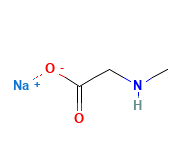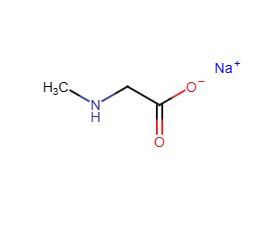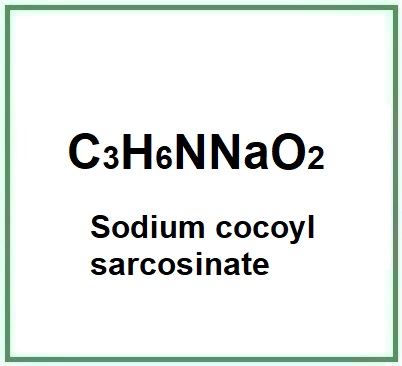![]() Sodium cocoyl sarcosinate
Sodium cocoyl sarcosinate
Rating : 5
| Evaluation | N. Experts | Evaluation | N. Experts |
|---|---|---|---|
| 1 | 6 | ||
| 2 | 7 | ||
| 3 | 8 | ||
| 4 | 9 | ||
| 5 | 10 |
0 pts from Al222
| Sign up to vote this object, vote his reviews and to contribute to Tiiips.Evaluate | Where is this found? |
| "Descrizione" about Sodium cocoyl sarcosinate by Al222 (20702 pt) | 2024-Jan-09 17:22 |
| Read the full Tiiip | (Send your comment) |
Sodium Cocoyl Sarcosinate is a chemical compound used primarily as a surfactant in personal care products.
The name describes the structure of the molecule:
- Sodium indicates the presence of sodium, a chemical element. In the context of surfactants, sodium is used to form salts with organic compounds.
- Cocoyl refers to the fatty acid derived from coconut oil. This indicates that the compound is a derivative of coconut fatty acid.
- Sarcosinate refers to sarcosinate, a functional group derived from sarcosine, an amino acid. Sarcosinates are known for their gentle cleansing and foaming properties.
Description of raw materials used in production:
Coconut Fatty Acids. Provide the lipid base, essential for surfactant formation.
Sarcosine. A derivative of a natural amino acid, contributes to foam formation and gentleness of the product.
Sodium. Used to neutralize and stabilize the formula, turning the mixture into a usable salt in skin and hair care products.
Industrial Production Process
- Extraction. Fatty acids are extracted from coconut oil.
- Reaction. The fatty acids are then combined with sarcosine, a derivative of a natural amino acid, to form sarcosinate.
- Neutralization. The compound is neutralized with sodium to form Sodium Cocoyl Sarcosinate.
- Purification. The final product is purified to remove any impurities and optimize quality.
- Quality Control. Sodium Cocoyl Sarcosinate undergoes quality testing to ensure purity, efficacy, and safety.
Form and Color
Sodium Cocoyl Sarcosinate typically appears as a viscous, transparent or slightly yellow liquid.

What it is for and where
- Used in skin and hair care products, such as shampoos, body washes, and facial cleansers, for its gentle cleansing ability, foam-forming capacity, and irritation reduction.
Cosmetics - INCI Functions
Cleansing agent. Ingredient that cleanses skin without exploiting the surface-active properties that produce a lowering of the surface tension of the stratum corneum.
Hair conditioning agent. A significant number of ingredients with specific and targeted purposes may co-exist in hair shampoo formulations: cleansers, conditioners, thickeners, matting agents, sequestering agents, fragrances, preservatives, special additives. However, the indispensable ingredients are the cleansers and conditioners as they are necessary and sufficient for hair cleansing and manageability. The others act as commercial and non-essential auxiliaries such as: appearance, fragrance, colouring, etc. Hair conditioning agents have the task of increasing shine, manageability and volume, and reducing static electricity, especially after treatments such as colouring, ironing, waving, drying and brushing. They are, in practice, dispersants that may contain cationic surfactants, thickeners, emollients, polymers. The typology of hair conditioning agents includes: intensive conditioners, instant conditioners, thickening conditioners, drying conditioners. They can perform their task generally accompanied by other different ingredients.
Surfactant - Cleansing agent. Cosmetic products used to cleanse the skin utilise the surface-active action that produces a lowering of the surface tension of the stratum corneum, facilitating the removal of dirt and impurities.
Safety
In general, according to a 2001 study, sarcosinates are not irritants and do not sensitize animal or human skin, although they may enhance the penetration of other ingredients through the skin. Therefore, care should be taken when formulating cosmetic products that contain these ingredients in combination with other ingredients. Available data are insufficient to support the safety of acylsarcosines and sarcosinates as cosmetic ingredients in products where they are likely to be inhaled (1).
A more updated study from 2021 finds that these ingredients are safe as used in cosmetics when formulated to be non-irritant, but they should not be used in cosmetic products in which N-nitrous compounds may be formed (2).
Molecular Formula C3H6NNaO2
Molecular Weight 111.08 g/mol
CAS 61791-59-1
UNII 1R9DUY89CZ
EC Number 263-193-2
 |  |
References_____________________________________________________________________
(1) Lanigan RS. Final report on the safety assessment of Cocoyl Sarcosine, Lauroyl Sarcosine, Myristoyl Sarcosine, Oleoyl Sarcosine, Stearoyl Sarcosine, Sodium Cocoyl Sarcosinate, Sodium Lauroyl Sarcosinate, Sodium Myristoyl Sarcosinate, Ammonium Cocoyl Sarcosinate, and Ammonium Lauroyl Sarcosinate. Int J Toxicol. 2001;20 Suppl 1:1-14. PMID: 11358107.
Abstract. This safety assessment addresses cosmetic ingredients that are N-acyl derivatives of sarcosine and are generally referred to as acyl sarcosines, and those that are salts, known generally as acyl sarcosinates. Previous assessments have addressed the safety of each of the fatty acids that appear in these acyl sarcosines and sarcosinates (Coconut Acid, Oleic Acid, Lauric Acid, and Myristic Acid). In each case the fatty acid was either safe for use or safe as used in cosmetic formulations. Acyl sarcosines are considered modified fatty acids with greater solubility and increased acidity of the carboxylic acid group compared to the parent fatty acid. They are used in a large number of cosmetic formulations as hair-conditioning agents and surfactant-cleansing agents. In soaps, concentrations are reported to be as high as 12.9%. These ingredients have low oral toxicity in rats. Although cytotoxic to Chinese hamster cells in culture, acyl sarcosines and sarcosinates are not mutagenic in those cells, nor in bacterial cells in culture. Carcinogenicity data were not available. These ingredients are nonirritating and nonsensitizing to animal and human skin, although they can enhance the penetration of other ingredients through the skin. For that reason, caution should be exhibited in formulating cosmetic products that contain these ingredients in combination with other ingredients whose safety is based on their lack of absorption or where dermal absorption is a concern (e.g., HC Yellow No. 4, Disperse Yellow 3). Because sarcosine can be nitrosated to form N-nitrososarcosine, a known animal carcinogen, these ingredients should not be used in cosmetic products in which N-nitroso compounds may be formed. With the above caveat, and based on the available data, it was concluded that these acyl sarcosines and sarcosinates are safe as used in rinse-off products. They may be safely used in leave-on products at concentrations up to 5%, the highest concentration tested in clinical irritation and sensitization studies. Oleoyl Sarcosine is used as a corrosion inhibitor in some aerosol products, at extremely low concentrations. In this circumstance, the ingredient is not being used as a cosmetic ingredient and this report is not intended to limit that use. Because of the absence of data on inhalation toxicity, however, it was concluded that the available data were not sufficient to support the safety of acyl sarcosines and sarcosinates as cosmetic ingredients in products where they are likely to be inhaled.
(2) Fiume, M. M., Bergfeld, W. F., Belsito, D. V., Hill, R. A., Klaassen, C. D., Liebler, D. C., ... & Heldreth, B. (2021). Amended Safety Assessment of Fatty Acyl Sarcosines and Sarcosinate Salts as Used in Cosmetics. International journal of toxicology, 40(2_suppl), 117S-133S.
Abstract. The Expert Panel for Cosmetic Ingredient Safety (Panel) assessed the safety of 5 acyl sarcosines and 9 sarcosinate salts as used in cosmetics; all of these ingredients are reported to function in cosmetics as hair conditioning agents and most also can function as surfactants—cleansing agents. The ingredients reviewed in this assessment are composed of an amide comprising a fatty acyl residue and sarcosine and are either free acids or simple salts thereof. The Panel relied on relevant new data, including concentration of use, and considered data from the previous Panel report, such as the reaction of sarcosine with oxidizing materials possibly resulting in nitrosation and the formation of N-nitrososarcosine. The Panel concluded that these ingredients are safe as used in cosmetics when formulated to be non-irritating, but these ingredients should not be used in cosmetic products in which N-nitroso compounds may be formed.
| Sign up to vote this object, vote his reviews and to contribute to Tiiips.EvaluateClose | (0 comments) |
Read other Tiiips about this object in __Italiano (1)
Component type: Chemical Main substances: Last update: 2024-01-09 17:03:39 | Chemical Risk: |


